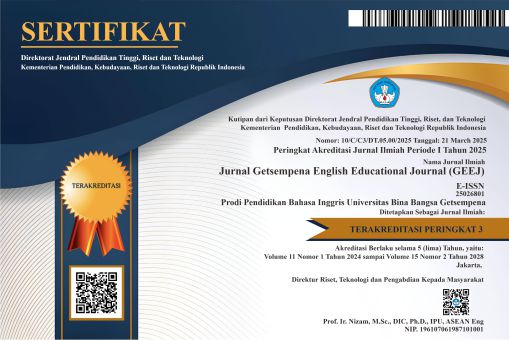DUOLINGO GAMIFICATION: DOES IT REDUCE STUDENTS’ GRAMMATICAL ERRORS IN WRITING?
Abstract
The study is aimed to examine the effectiveness of Duolingo Gamification Platform to reduce the students' grammatical errors in writing a report text. The participant of this study were 25 students in the second grade of Methodist Senior High School in Banda Aceh, Indonesia. The research utilized a pre-experimental design with one group pre-test post-test. The instrument of this study is a test divided into pre and post-test. The data were analyzed using the t-test. The study revealed that the mean score of the pre-test is 53.8, and the mean score of post-test is 55.4. The standard deviation for pre-test was 7.18 and for post-test were 7.29 and the score of the standard of error of pre-test was 1.43 and post-test was 1.45. The t-score of the study was 4.0, with the degree of freedom 24,and the t-table was 1.69. The data showed that the t-score was higher than t-table, which leads us to the interpretation that the Ha was accepted and H0 was rejected. It indicated that the use of Duolingo Gamification platform was sufficient to reduce the students' grammatical errors in writing report text. Therefore, the platform was highly recommended to use to increase the quality of students’ writing skill, especially in the report text.
References
Association, G., & Docomo, N. (2013) Children's' use of mobile phones an international comparison 2012. Lonon: The London School of Economics and Political Science.
De Castro, A. P., Macedo, S. D., Basto. H. P. P. (2016) Duolingo: An Experience in English Teaching. Journal of Educational and Instructional studies in the world. 6 (4). 59-63.
Jones, T. (2014). Students'cell Phone addiction and their Opinions. The Elon Journal of Undergraduate Research in communications, 5(1), 74-80.
Klimova, B (2012). The Importance of Writing. Paripex - Indian Journal of Research. 2. 9-11.
Leonard, K. (2019) Importance of Written Communication in Business. Retrieved from https://smallbusiness.chron.com/importance-written-communication-business-2936.html. Accessed on May 18th, 2019
Mehtala, H. (2015). The affordances of Duolingo for Mobile-Assisted Language Learning (A sociocultural and ecological perspective). The University of Oulu, Oulu (Unpublished).
Paul Magnuson. (2004) Teaching with Duolingo. New York: Sage Publication.
Riasanti, M. J., Allahyar, N., & Tan, K. E. (2012). Technology in Language Education: Benefits and Barriers. Journal of Education and Practice. 3 (5), 25-30.
Salvation, M. D. (2017). The relationship between smartphone applications usage and students' academic performance. Computational Methods in Social Sciences. 5 (2). 26-39.
Sugiyono. (2015) Metode Penelitian Pendidikan Pendekatan Kuantitatif, Kualitatif, dan R&D. Bandung. Alfabeta.
Wright, W. E. (2015). Foundations for Teaching English Language Learners: Research, Theory, Policy, and Practice (2nd ed.). Philadelphia, PA: Caslon Publishing
























